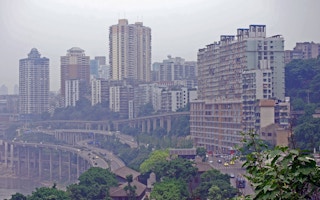Is your city suffering because of excessive truck movements within the city that result in unsafe traffic conditions, gridlock congestion, and toxic air pollution? If yes, then read on about how a city in the People’s Republic of China (PRC) is transforming its freight logistics systems to overcome all these problems.
Chongqing is a major city along the upper reaches of the Yangtze River in southwest PRC. My first visit there rendered me both awestruck and a little disappointed.
I was truly amazed by the modern infrastructure, which included many exquisitely designed bridges across the Yangtze and Jialing rivers and also an aerial tramway system that allows visitors to enjoy some breathtaking views of the city.
However what disappointed me was the severe traffic congestion. This of course is a common problem in many cities, but in the case of Chongqing, it is exacerbated by a line of trucks in the inner city so long that the trucks actually end up occupying one full lane of traffic during rush hour.
Also one can often see a large number of trucks parked or idling close to major residential areas causing more congestion and air pollution.
I learned later that this is a result of the city’s logistics infrastructure—warehouses, container handling and storage depots, and transport companies—all of which are housed in multiple locations within the inner city area. The back-and-forth movement of trucks to these multiple locations causes havoc with the city’s transportation system.
What’s wrong with the logistics in Chongqing? Reputed to be a world-class mega city, it suffers from surprisingly poor logistics infrastructure. Most of the existing warehouses are located in the inner city area and are old, inadequate and non-mechanized.
Goods are transferred several times from one location to another in the distribution chain without integrated freight handling facilities that link up different transport modes – road, rail, and waterway. Goods movements are excessively dependent on road transport, which congests the highways, disrupts city traffic, and creates poor living conditions within the city.
Given all the problems described above, it is no surprise that the government is keen to find solutions quickly. For starters, municipal authorities have already imposed restrictions on the movement of trucks within the inner city during certain times of the day. However that is a short-term solution that results in further delays in the delivery of goods, and increases costs. The good news is that there are more sustainable solutions being developed:
1. Modern logistics parks. Chongqing plans to create new state-of-the-art logistics parks beyond the inner ring road, and combine all logistics functions in one location. The parks will be connected by road, rail and waterway, and thus optimize the use of different transport modes.
They will be large and well planned, with mechanized storage systems. These improvements will reduce logistics costs, which in turn should help lower the price of consumer goods.
2. Supporting new trade routes by rail. Let me first mention an interesting fact: Chongqing is the world’s largest production base for laptops. In 2014, 61 million laptops were made in the city, one-third of the world’s total. Other electronic devices—desktop computers, printers, etc.—are also produced in Chongqing makes it a huge export hub.
As such, it needs good connectivity to markets in Europe, and traditionally this came in the form of maritime transport. The goods were first transported by road or rail to the ports on the PRC’s eastern coast and then shipped by sea to Europe. This took a long time, nearly 40 days, and involved several transshipments. This is gradually changing as goods are now moved directly from Chongqing to Germany by rail in a mere 12-16 days.
The 11,000-km Chongqing-Europe Railway Corridor is becoming increasingly popular and traffic demand is steadily growing. To do so, it requires upgraded logistics to handle transshipments and related processes such as sorting, packaging, and storage – all of which will be provided by the new logistics park that is under development in Chongqing.
“
What’s wrong with the logistics in Chongqing? Reputed to be a world-class mega city, it suffers from surprisingly poor logistics infrastructure.
3. Promoting river transport. One obvious solution to relieving the city’s highways is to encourage more transport on the rivers. Chongqing is located on the Yangtze River and is ideally positioned to develop its inland waterway transport system.
The city is developing its river ports and also promoting roll-on roll-off (Ro-Ro) ships, designed to carry rolling cargo that does not require cranes for loading or off-loading. Ro-Ro ships allow wheeled cargo, such as trucks and trailers, to be driven on and off the ship on their own wheels.
This reduces the labor, equipment, and time required in port, lowers transport costs, and improves the quality of freight delivery service – thus making inland water transport a very attractive option for transporters.
ADB recently approved a $150 million loan to support all the above initiatives to overhaul logistics in the city and relieve it of its multiple infrastructure problems. We hope that Chongqing may provide the inspiration for other Asian cities to reform their logistics systems and improve their livability.
Sharad Saxena is principal transport specialist, East Asia Department, Asian Development Bank. This article is republished from the ADB Blog.


















